LISTEN ON YOUR FAVE PLATFORM: Apple // Audible // Google
I’m so excited about this episode. This is for anyone who ever feels like there are just to many tabs open in your brain. Or in other words, anyone feeling overwhelmed.
Today we are talking about my favorite simple strategy for when I’m feeling overwhelmed or over tasked. This is what I use when my brain is just at capacity….
This method will take you from guessing to knowing where to work from.
We’re talking about using the brain dump method maximized through the Eisenhower Matrix! That sounds a bit fancy, but it’s super easy, and I promise that if you use the simple methods I’ll walk you through in this episode, you’ll have greater focus, minimized stress, and be able to see more clearly the next right steps…
Overwhelm can take over at a second’s notice. We go from ‘I’ve got this’ to ‘I don’t got it’ as quickly as when someone yells heads-up, just in time for you to look up and get smacked in the face by a football.
Use this method every time you’re either starting a new project or when you’re worried about dropping balls somewhere and having everything (including you) fall apart.
I’m talking about brain dumps, but elevated using the Eisenhower Matrix!
We can use brain dumps to create greater focus, minimize stress, and just see more clearly the next right steps. Now I know what you’re thinking, “oh, I, I know how to do brain dumps.” I know you do. I totally know you do. But I’d love to share how I use them because I think I can give you a couple of tips and tricks to make your brain dumps even more effective.
This episode will help:
👉 Learn how to use brain dumps to get organized and focus
👉 The overwhelmed and at-capacity mom get back to a balanced flow
👉 Anyone finding it hard to sleep at night because there’s too much in your head
👉 When you get stuck knowing what your next steps should be and in what order
In this episode:
3:09 A simple and effective strategy to handle overwhelm
5:36 Power of subtraction
7:00 Defining Highest Priority
8:17 Bringing order to our chaos
10:05 Working with our calendar
12:52 A clear first and last step
How do to an organizational brain dump with the Eisenhower Matrix
There are really two different kinds of brain dumps. There’s the emotional brain dump where you’re almost using it like a therapy session, like a journal, and you’re just dumping out all of the feelings.
Those are great and I love a good emotional dump session, but today let’s focus on organizational brain dumps. This is what I love and what I use regularly.
We’re also talking about the Eisenhower Matrix, which is named for Dwight D. Eisenhower 34th president of the United States.
Here’s what you need to know about Eisenhower. His productivity game was strong. I mean, he was doing more in weeks than others do in months and not just that, he sustained it not for years but for decades.
He had an incredible skill of organizing what was important vs. not, urgent vs. not, and getting them in the proper order.
So we have what looks like the game of 4-square drawn out on paper. The top left corner is block 1: It’s all the tasks that are both urgent and important.
Next to block 1 taking the top Right spot is block 2. Marked not urgent but important.
This block deserves special attention. These are often those items that will move your business forward, but because they’re not urgent they easily fall to the side, don’t let that happen! Keep this quadrant high priority.
Because the left side of our matrix is Urgent we come down to block 3 on the bottom left, and it’s titled: ‘urgent but not important’.
Our final block on the bottom right corner is block 4: These are not important and not urgent.
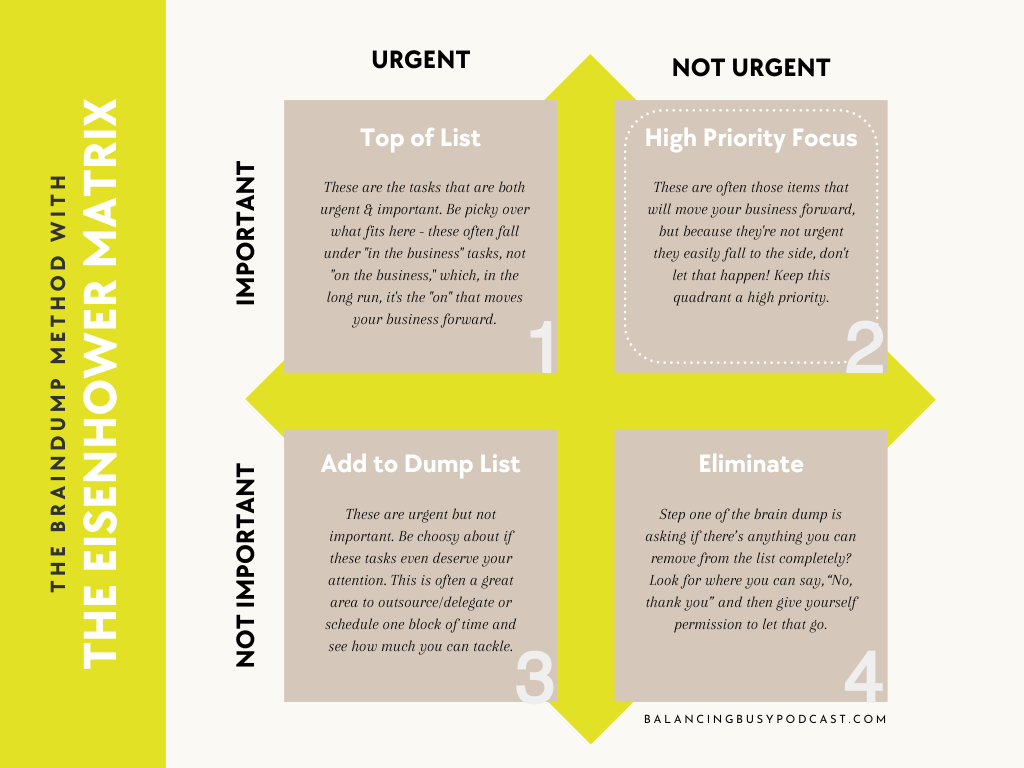
Step 1: Dump it all out
To start a brain dump, we simply dump it all out. It’s the equivalent of dumping a puzzle out onto the table. You just let everything fall out.
There’s no judgment; there’s no concern as to where it all lands, you’re just letting all the things on your mind, all of those action items fall out. Either onto a piece of paper, I always use paper and pen, but you could literally use anything! A google doc, grease board, sticky notes, your iPad, or your Remarkable, you’re just getting all the thoughts out with no concern about where they fall.

Step 2: Organize Your Brain Dump with the Eisenhower Matrix
Once everything is out, start giving each task a ranking (you can also draw out a 4 grid on a new sheet of paper and start moving each item to where it best fits).
Give it a 1 for Important & urgent
Give it a 2 for Important but not urgent
Give it a 3 for Not important but urgent
Give it a 4 for Not important & not urgent
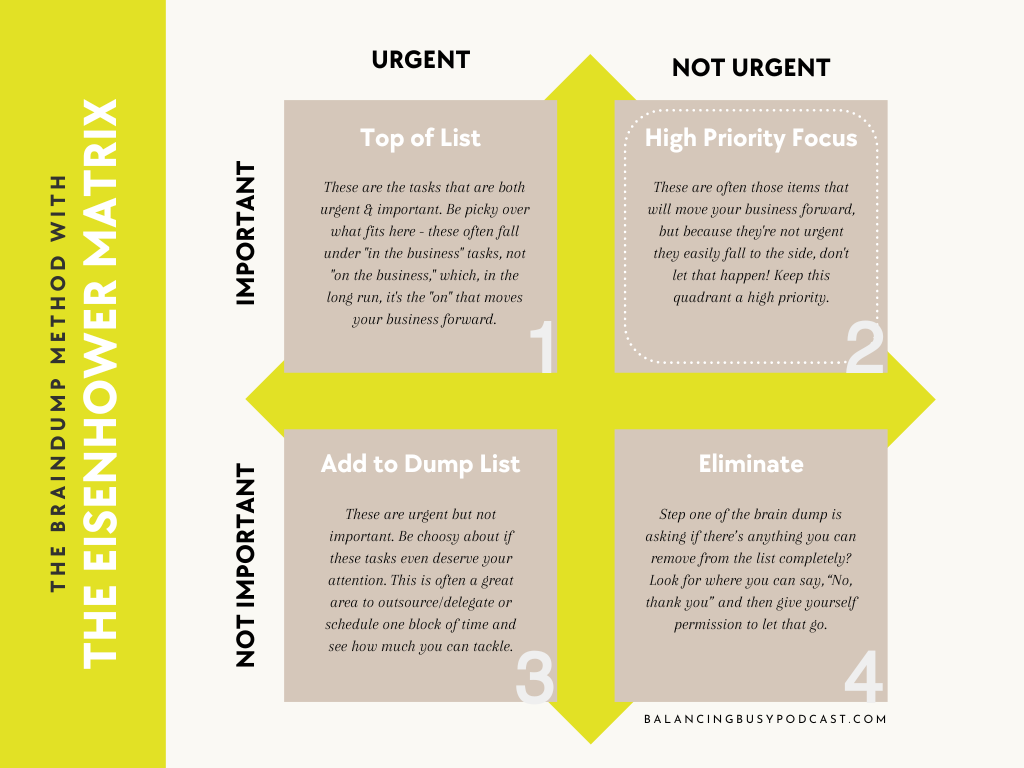
Step 3: Time to Slash – What can you Remove?
Now that you’ve dumped all of your thoughts out onto paper, we’re going straight to anything you numbered a 3 (not important but urgent) or a 4 (not important & not urgent).
We’re looking for anything that you can SUBTRACT.
James Clear has a quote that goes something like, ‘The best form of time management is saying no’.
So let’s just start by looking at everything we’ve dumped out and seeing if there’s anything we get to just say, “no, thank you” to. Look for the things that don’t even need to be done, the things that are actually not really a priority at all.
Time for a shameless plug, but I do have an incredible podcast episode with Leidy Klotz about the power of subtraction. In his book, Subtract, Leidy talks about the idea that when there is a problem, our go-to instinct is to figure out what we need to add, even though, often, subtraction could be a better solution. It’s just that our minds don’t automatically go to subtraction. We go to addition.
So that’s where I want you to start. You’re looking at this big messy list, and the first thing to ask is, is there anything that you get to slash and cross out?
Often there are things we feel like we need to do, but upon further investigation, we really don’t! They are not moving the needle forward, they’re not helping our goals, and they’re not even necessary.
Step 4: Creating your action plan (with the best ‘next right step’)
Once I’ve cut the unnecessary… I want to take the leftover scattered action items and turn them into a chronological action plan. This is step 3. I do this by going to all of the 1’s and numbering or lettering them.
1a
1b
1c…etc.
I’m looking for the obvious – keeping with my puzzle analogy – you’d look for the corners and the frame…
Those are the highest priorities.
But how do we decide what’s important?
First, decide if any tasks are urgent or have a deadline attached to them, those will be your obvious first steps. Once we’ve got any of those identified I like to look for the things that will make the biggest impact.
How do we decide what’ most impactful?
When I’m judging based on biggest impact, I am really looking for two things to be solved.
Number one: Can it make me more money?
Number two: Can it save me more time?
If there are several tasks that could check those boxes then I simply ask, well, which one can save me the most time? Which one could make me the most money? Those are going to naturally rise up and become higher up on the list.
These items in my “1” square will become my top 5 action items and I’ll move those to my daily 5. these are the next things I’m going to do. I now know exactly what my priorities for the day are.
But before I jump into those, I need to finish organizing my list…
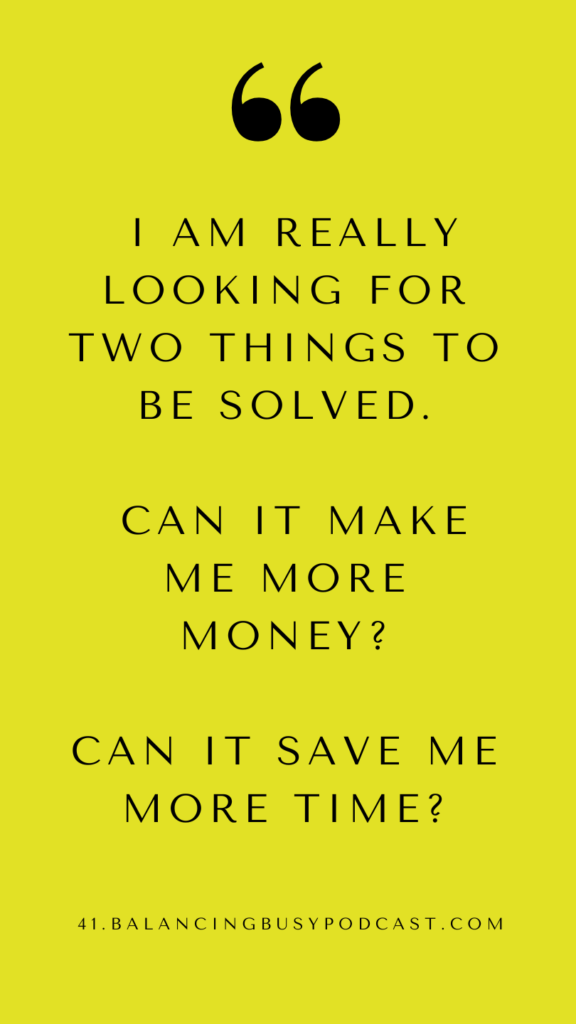
Step 5: Scheduling and Shifting
I start moving the rest of the big items to my calendar, especially Block 2: Important but not urgent — I’m literally saying, oh, line number 2a, this thing. Okay, where can I fit it in this week so I get it done? I’m blocking out a 30-minute chunk. I’m getting that done. And I start pushing all of these items into my calendar.
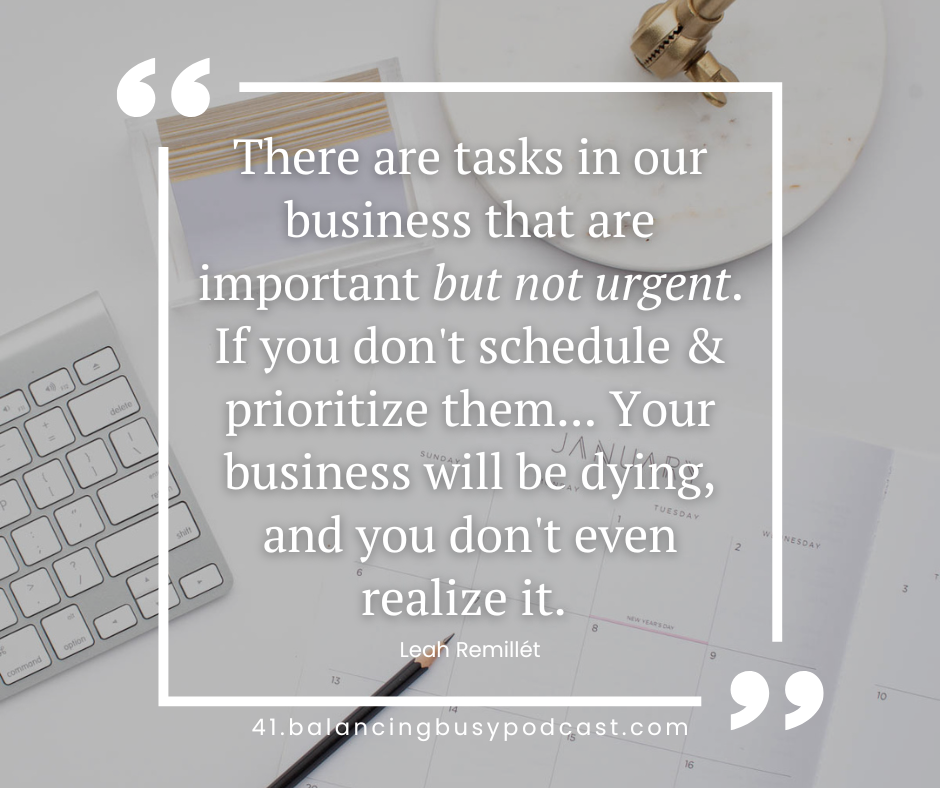
So block 1 – urgent and important probably went to my daily 5 list.
Block 2: Important but not urgent – got scheduled into my calendar, and that leaves: block 3: Not important, but urgent and block 4: Not important & not urgent
Those tasks go onto a separate to-do list in a planner, notepad, in the Remind app, or the Notes app. They will either be delegated out, outsourced, or filed away for later. If there are tasks, I need to do later than I schedule a block of time to review those, THEN close that list or hide it in a drawer.
Now I’m ready to take on the important tasks (and I’m clear about what they are). I move them to my daily five. (I have an amazing free printable for my daily routine and a podcast episode explaining how I use it here) and then I put the big list away, and tomorrow I can grab the next five items if I need to, move those to my daily five, and keep making progress.
And then suddenly, we’re not so overwhelmed because it’s all out of our head, prioritized and organized, and blocked out in our calendars with time to get it all done.
Try a brain dump with the Eisenhower Matrix right now!
Use a brain dump when you’re planning your next project. Work with it when you’ve just got too many tabs open in your brain or if you’re struggling to fall asleep or feel at peace.
The key is to stop trying to remember all of the things in your head and instead get them onto paper or into an app, however you like to do it, and then move them into a sequential or linear format.
The brain dump method takes all that chaotic messiness and organizes it so that I can identify a clear first step and last step.
If you are finding yourself in one of those moments where there are just too many thoughts banging around in your head, try the brain dump.
LINKS YOU’LL LOVE:
I’d love to connect and know your thoughts on this episode. Find me on Instagram!
Want to learn how to drop an entire workday a week? Grab my FREE COURSE
Desktop a hot mess? Organize your desktop in 10 minutes!
OTHER EPISODES YOU’LL LOVE:
Episode 3: 5x Your Productivity with this 5-Minute Ritual (explains the daily 5)
Episode 28: Outsourcing Explained (Pt 1)
Episode 22: Keeping a Clean Home When You Don’t Have Time
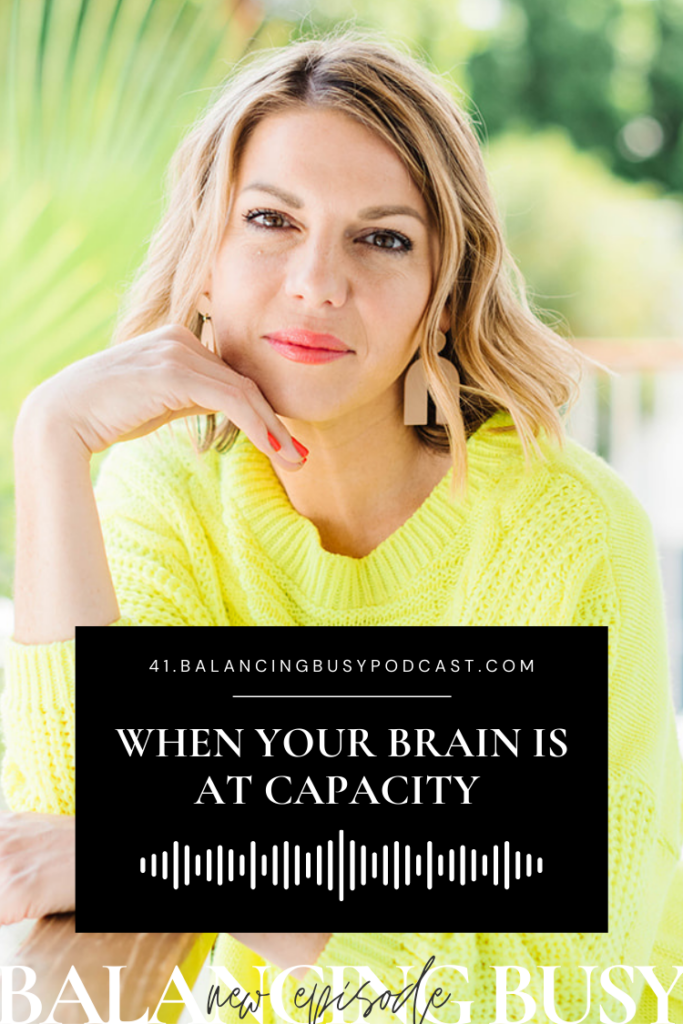

you said: